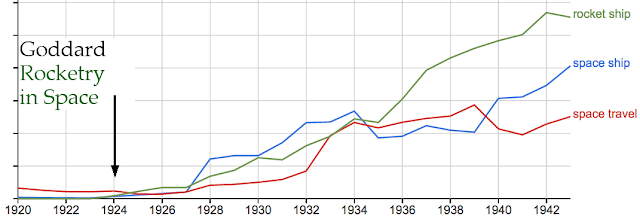 |
| 1941: Reason Original cover art: Stephen Youll |
I like to imagine that QT-1, Michael Donovan and Gregory Powell might have existed in a previous Reality, what I call the Foundation Reality. In that Reality, both space travel technology and artificial intelligence research zoomed ahead at a faster pace than in our universe.
 |
| Origins of the Science Fiction genre. |
 |
| here |
The graph, above, also shows the time period in the 20th century when the term "science fiction" came into common use. In 1953, a book called Modern Science Fiction was published and it included an article by Asimov.
Asimov wrote about "Social Science Fiction", which he contrasted with earlier types of science fiction that might be called "gadget stories" or technology-oriented "adventure stories". There is nothing wrong about including cool gadgets and rousing adventure in science fiction stories, but Asimov was among a group of scientifically-literate authors who could think deeply and creatively about the impact of science on society. By including in their stories reasoned speculation about how science could impact human societies, authors such as Asimov, Robert Heinlein and Arthur C. Clarke could take the science fiction genre to a new level of sophistication.
 |
| The origins of a science of space travel and space travel in science fiction. |
 |
| Rockets? Who needs rockets? 1930 cover art by Hans Wessolowski |
In 1920, Robert Goddard's early suggestion that rockets could function in space was ridiculed in a New York Times editorial. 49 years later, The New York Times finally published an apology for their ignorant dismissal of rocket-powered space travel, doing so just a few days before the first man walked on the Moon.
 |
| An early science fiction rocket ship cover by Nick |
In 1924, Robert Goddard published an account in Popular Science of how chemical rockets could work in outer space. Soon there were science fiction stories that made use of the idea of a "rocket ship" that could travel to distant planets. Rocketry was taken more seriously in Germany than in the United States. In 1929, Woman in the Moon was an early film depiction of travel in space using rocket propulsion.
 |
| Rocket ships and ray guns. Early Asimov; cover by Robert Sherry |
The young Isaac Asimov grew up right when the first science fiction magazines were available for him to read in his family's candy store. He started publishing his own stories when John Campbell had taken editorial control at Astounding. Asimov had become impatient with some of the tired old science fiction story plots of the pulp magazine era. For example, he disliked all of the clanking murderous robots that had been included in science fiction stories and he knew that it was silly to imagine the existence of human-like residents on nearby planets such as Mars and Venus. Asimov, as a writer of science fiction, was ready to be pushed in new literary directions by Campbell.
Science Fiction in 1953
 |
| a more mature Asimov |
 |
| in the Ekcolir Reality original cover art by Henry Van Dongen and Edmund Emshwiller |
 |
| 1953 |
 |
| Nanopore |
2 Heinlein - "Speculative Fiction"
3 Clarke - Childhood's End
1953 in the Asimov Reality
Next: a new investigation of the Asimov Reality
 |
| visit the Gallery of Book and Magazine Covers |

No comments:
Post a Comment